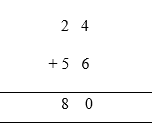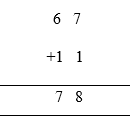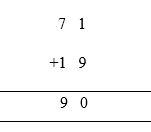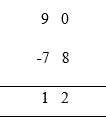Number
Definition
It is a mathematical symbol that is used to count, measure, and label/sort/order. There are different kinds of numbers such as.
Examples
Example of numbers are 1, 2, 3, 4, 5, 6, 7, 8, 9, 0.
Need of Numbers
Ancient humans used to count animals and other useful things by marking on bones, woods, stone, or walls. To count things, they used to draw a line ( | ) for one and similarly four such lines they would draw and the fifth line would be a cross over others straight lines to show that the set of 5 has been completed. Although this method was feasible or practicable, however, for large counting this method was ill-considered.

Brief History
The evolution of today’s numbers, that are 0,1,2,3,4,5,6,7,8,9, can be traced back. In ancient times, there were numeral systems developed to represent numbers. The first such known system was the Egyptian ciphered numeral system, followed by the Greeks’ Ionic / Ionian / Milesian / Alexandrian Numerals. Later, the Roman numeral system remained popular throughout Europe until in the 1st and 4th centuries, the Indian mathematicians introduced the Hindu-Arabic Numeral System.
Al-Khwarizmi and Al-Kindi were amongst the other Muslim mathematicians who spread the Hindu-Arab Numeral System in Europe through their books. Thus, this system of numeration was famous by the name ‘Arabic Numerals’ in Europe.
Uses of Numbers
Following are some uses of numbers.
- They are accepted and understood globally by everyone irrespective of the region they may belong to.
- Using numbers helps us to predict data and analyze the statistics better.
- It is used in phone numbers, or mobile numbers to keep the identity of the caller different from others.
- Every locker uses a number which distinguish it from other lockers and the owner must remember his locker number to avoid confusion.
- Bar code, which primarily consist of numbers, is used in marts to identify things and in hospitals to give each patient their identity.
- Numbers are basics for mathematics and its related subjects.
- Numbers are used to show weather or human body temperature.
- Books’ pages are also given numbers called page numbers
- In sports, numbers are used to show the score of a player or sportsman / sportswoman.
Number Words
Definition
Number words are the representation of numbers in word form. It is also called ‘number in words’ or ‘number names’. For example, we can represent the number 1 in words as ‘One’. Similarly, the number 0 can be written as ‘Zero’.
Rules
To write any number in words or figures we must follow some rules or steps. Those are.
Rule 1:
Always remember the position of a digit or number such as unit, tens, hundreds etc. If the number is a single digit it must belong to category of 0 – 9 and it is always in units or one’s place. Similarly, if it is a two-digit number, it must be in the range of 10 – 99 and it can be written in both unit and ten columns.
- 1 – Ones / Units column.
- 10 – Tens and Unit column from left to right.
- 100 – Hundred, tens, and unit’s column from left to right.
- 1000 – Thousand, hundreds, tens, and unit column from left to right.
| Ten Thousand | Thousand | Hundred | Tens | Unit |
| 1 | 0 | 0 | 0 | 0 |
Rule 2:
For the numbers between 0 – 20, we must remember their names such as, zero, one, two, three, four, five, six, seven, eight, nine, ten, eleven, twelve, thirteen, fourteen, fifteen, sixteen, seventeen, eighteen, nineteen, twenty. We can always refer to the number chart below.
Rule 3:
We have special names for these multiple of tens; 10, 20, 30, 40, 50, 60, 70, 80, 90, 100. They are ten, twenty, thirty, forty, fifty, sixty, seventy, eighty, ninety, hundred.
Rule 4:
For the rest of numbers i.e., 21 – 29 we write the prefix twenty which is followed by one, two, three for 21, 22, 23. Similarly, for 31 – 39 we use the prefix thirty and followed by one, two, three for 31, 32, and 33 respectively. This rule applies to 41 – 49, 51 – 59, 61 – 69, 71 – 79, 81 – 89, 91 – 99, using the prefixes forty, fifty, sixty, seventy, eight, and ninety respectively.
Rule 5:
Numbers above 100 uses the same prefix rule, however, there is no exception or special name for 110, 120, 130, 140, 150, 160, 170, 180, …. Rather, we repeat the special names mentioned in rule 2 and 3. So, prefix one hundred (or hundred) followed by ten, twenty, thirty, forty, fifty, sixty, seventy, eighty, …. For a number between 100 – 110 we can explain it by an example.
| Hundred | Tens | Unit |
| 1 | 0 | 2 |
| One hundred two |
For a number between 110 – 120, let us take an example of 113. We have 13 in the tens place; we can use rule number 2. Prefix hundred will be used.
| Hundred | Tens | Unit |
| 1 | 1 | 3 |
| One hundred thirteen |
For a number between 150 – 160, we pick 159 as an example. We have 59 in the tens place which can be written in words as nine preceded by the prefix fifty according to rule number 4. We also have a one in the hundred places, so we will use the prefix hundred as well.
| Hundred | Tens | Unit |
| 1 | 5 | 9 |
| One hundred fifty-nine |
Rule 6:
It can be called as the big number rule. We have special names for big numbers such as thousand for 1000, a million for 1,000,000, a billion for 1,000,000,000.
Numbering Systems
The basic rules are the same, however, to represent a larger number such as 100000, 1000000, we use two systems which can be used for numbering i.e., writing numbers into words. Those are the international numbering system and the Indian numbering system.
International Numbering System
The international numbering system is used globally. This numbering system uses the same rules as described above, however, for a large number such as 1000 thousand is called Million. 1000 million is called trillion.
In terms of power, the international system can be expressed as 100, 101, 102, 103, 104, 105 for one, tens, hundreds, thousands, ten thousand, hundred thousand. Rest of the higher powers uses a general formula which is 106+3n. If n=0, it is 106 which corresponds to one Million. If n=1, term simplifies to 109 which is one Billion (1000 million). Similarly, for n=2, it is one trillion (1000 billion) and for n=3, it is one Quadrillion (1000 trillion).
Separator is a comma that is placed in bigger or larger numbers. When writing a number without separations there is high chances of a digit being ignored or missed. Therefore, a separator or simply a comma ( , ) is used to avoid confusion while writing large numbers.
In the international system for numbering, a separator is placed every three digits from right to left. For example
- 531,164 – Five hundred and thirty-one thousand, one hundred and sixty-four.
- 10,112,884 – Ten million, one hundred and twelve thousand, eight hundred and eighty-four.
- 3,678,329,414 – Three billion, six hundred and seventy-eight million, three hundred and twenty-nine thousand, four hundred and fourteen.
- 679,391,284,333 – Six hundred and seventy-nine billion, three hundred and ninety-one million, two hundred and eighty-four thousand, three hundred and thirty-three.
| Hundred Billion | Ten Billion | Billion | Hundred Million | Ten Million | Million | Hundred thousand | Ten thousand | Thousands | Hundreds | Tens | Ones |
| 5 | 3 | 1 | 1 | 6 | 4 | ||||||
| 1 | 0 | 1 | 1 | 2 | 8 | 8 | 4 | ||||
| 3 | 6 | 7 | 8 | 3 | 2 | 9 | 4 | 1 | 4 | ||
| 6 | 7 | 9 | 3 | 9 | 1 | 2 | 8 | 4 | 3 | 3 | 3 |
Indian Numbering System
Indian numbering system is most widely used in the countries like India, Pakistan, Bangladesh, Bhutan, Maldives, Nepal. In the Indian numbering system, we use the term one Lac for 100,000. Similarly, we use ten Lac for 1000000, One Crore for 10 million.
The Indian numbering system can be expressed in the powers of 10 such as 100, 101, 102, 103, 104 for ones, tens, hundreds, thousands, ten thousand. Higher power of 10 uses a general formula for their naming which is 105+2n, meaning that for every odd power of 10, we will have a different name for the number. For n=0, formula becomes 105 which is called One Lac (lakh). For n=1, the general formula reduces to 107 which is One Crore. It continues as 109 for Arab, 1011 for Kharab.
In the Indian numbering system, separators are used differently than the international system. Starting from the right most digit, first separator is after three digits, then separator is placed every two digits. For example
- 4,29,124 – Four lakhs, twenty-nine thousand, one hundred and twenty-four.
- 1,00,12,981 – One Crore, twelve thousand, nine hundred, and eighty-one.
- 1,21,42,56,126 – One Arab, twenty-one crore, forty-two lakhs, fifty-six thousand, one hundred, and twenty-six.
- 4,23,56,76,91,999 – Four Kharab, twenty-three Arabs, fifty-six crores, seventy-six lakhs, ninety-one thousand, nine hundred, and ninety-nine.
| Kharab | Ten Arabs | Arab | Ten Crores | Crores | Ten Lakhs | One Lakhs | Ten thousand | Thousands | Hundreds | Tens | Ones |
| 4 | 2 | 9 | 1 | 2 | 4 | ||||||
| 1 | 0 | 0 | 1 | 2 | 9 | 8 | 1 | ||||
| 1 | 2 | 1 | 4 | 2 | 5 | 6 | 1 | 2 | 6 | ||
| 4 | 2 | 3 | 5 | 6 | 7 | 6 | 9 | 1 | 9 | 9 | 9 |
Number Words Chart 1 – 10
The numbers from 1 to 10 are expressed in words in the following table.
| Number | Words | Number | Words |
| 1 | One | 6 | Six |
| 2 | Two | 7 | Seven |
| 3 | Three | 8 | Eight |
| 4 | Four | 9 | Nine |
| 5 | Five | 10 | Ten |
Number Words Chart 11 – 20
The numbers from 11 to 20 are expressed in words in the following table.
| Number | Words | Number | Words |
| 11 | Eleven | 16 | Sixteen |
| 12 | Twelve | 17 | Seventeen |
| 13 | Thirteen | 18 | Eighteen |
| 14 | Fourteen | 19 | Nineteen |
| 15 | Fifteen | 20 | Twenty |
Number Words Chart 21 – 40
Numbers from 21 to 40 in words are given in the following table.
| Number | Words | Number | Words |
| 21 | Twenty-One | 31 | Thirty-One |
| 22 | Twenty-Two | 32 | Thirty-Two |
| 23 | Twenty-Three | 33 | Thirty-Three |
| 24 | Twenty-Four | 34 | Thirty-Four |
| 25 | Twenty-Five | 35 | Thirty-Five |
| 26 | Twenty-Six | 36 | Thirty-Six |
| 27 | Twenty-Seven | 37 | Thirty-Seven |
| 28 | Twenty-Eight | 38 | Thirty-Eight |
| 29 | Twenty-Nine | 39 | Thirty-Nine |
| 30 | Thirty | 40 | Forty |
Number Word Chart 41 – 60
Number in words from 41 to 60 are in the following table.
| Number | Words | Number | Words |
| 41 | Forty-One | 51 | Fifty-One |
| 42 | Forty-Two | 52 | Fifty-Two |
| 43 | Forty-Three | 53 | Fifty-Three |
| 44 | Forty-Four | 54 | Fifty-Four |
| 45 | Forty-Five | 55 | Fifty-Five |
| 46 | Forty-Six | 56 | Fifty-Six |
| 47 | Forty-Seven | 57 | Fifty-Seven |
| 48 | Forty-Eight | 58 | Fifty-Eight |
| 49 | Forty-Nine | 59 | Fifty-Nine |
| 50 | Fifty | 60 | Sixty |
Number Words Chart 61 – 80
Number in figures or words are in the following table.
| Number | Words | Number | Words |
| 61 | Sixty-One | 71 | Seventy-One |
| 62 | Sixty-Two | 72 | Seventy-Two |
| 63 | Sixty-Three | 73 | Seventy-Three |
| 64 | Sixty-Four | 74 | Seventy-Four |
| 65 | Sixty-Five | 75 | Seventy-Five |
| 66 | Sixty-Six | 76 | Seventy-Six |
| 67 | Sixty-Seven | 77 | Seventy-Seven |
| 68 | Sixty-Eight | 78 | Seventy-Eight |
| 69 | Sixty-Nine | 79 | Seventy-Nine |
| 70 | Seventy | 80 | Eighty |
Number in Words Chart 81 – 100
| Number | Words | Number | Words |
| 81 | Eighty-One | 91 | Ninety-One |
| 82 | Eighty-Two | 92 | Ninety-Two |
| 83 | Eighty-Three | 93 | Ninety-Three |
| 84 | Eighty-Four | 94 | Ninety-Four |
| 85 | Eighty-Five | 95 | Ninety-Five |
| 86 | Eighty-Six | 96 | Ninety-Six |
| 87 | Eighty-Seven | 97 | Ninety-Seven |
| 88 | Eighty-Eight | 98 | Ninety-Eight |
| 89 | Eighty-Nine | 99 | Ninety-Nine |
| 90 | Ninety | 100 | Hundred |
Number Words – teen family chart
The numbers that belong to teen family are listed.
| Teen Family | |
| Number | Words |
| 13 | Thirteen |
| 14 | Fourteen |
| 15 | Fifteen |
| 16 | Sixteen |
| 17 | Seventeen |
| 18 | Eighteen |
| 19 | Nineteen |
Number Words – Ty Family Chart
Numbers that are in ty – family are.
| Ty Family | |
| Number | Words |
| 20 | Twenty |
| 30 | Thirty |
| 40 | Forty |
| 50 | Fifty |
| 60 | Sixty |
| 70 | Seventy |
| 80 | Eighty |
| 90 | Ninety |
Multiples of Hundred Chart
The multiples of hundreds are 100, 200, 300, 400, 500, 600, 700, 800, 900. They are expressed in words by adding prefix One, Two, Three to the word hundred such as as ‘One Hundred’, ‘Two Hundred’, ‘Three Hundred’, Four Hundred’, ‘Five Hundred’, ‘Six Hundred’, ‘Seven Hundred’, ‘Eight Hundred’, ‘Nine Hundred’.
| Multiples of Hundred | |
| 100 | Hundred (One Hundred) |
| 200 | Two Hundred |
| 300 | Three Hundred |
| 400 | Four Hundred |
| 500 | Five Hundred |
| 600 | Six Hundred |
| 700 | Seven Hundred |
| 800 | Eight Hundred |
| 900 | Nine Hundred |
Multiples of Thousands
A thousand is basically ten hundred. It is written as 1000. Multiples of thousands have the prefix One, Two, Three and so on followed by the word thousand itself. For example, ‘One Thousand’, ‘Two Thousand’, ‘Three Thousand’, ‘Four Thousand’, ‘Five Thousand’, ‘Six Thousand’, ‘Seven Thousand’, ‘Eight Thousand’, ‘Nine Thousand’, ‘Ten Thousand’. They are listed in the following table.
| Multiple of Thousands | |||
| Number | Words | Number | Words |
| 1000 | One Thousand | 11000 | Eleven Thousand |
| 2000 | Two Thousand | 12000 | Twelve Thousand |
| 3000 | Three Thousand | 13000 | Thirteen Thousand |
| 4000 | Four Thousand | 14000 | Fourteen Thousand |
| 5000 | Five Thousand | 15000 | Fifteen Thousand |
| 6000 | Six Thousand | 16000 | Sixteen Thousand |
| 7000 | Seven Thousand | 17000 | Seventeen Thousand |
| 8000 | Eight Thousand | 18000 | Eighteen Thousand |
| 9000 | Nine Thousand | 19000 | Nineteen Thousand |
| 10000 | Ten Thousand | 20000 | Twenty Thousand |
| Multiple of Thousands | |||
| Number | Words | Number | Words |
| 21000 | Twenty-One Thousand | 31000 | Thirty-One Thousand |
| 22000 | Twenty-Two Thousand | 32000 | Thirty-Two Thousand |
| 23000 | Twenty-Three Thousand | 33000 | Thirty-Three Thousand |
| 24000 | Twenty-Four Thousand | 34000 | Thirty-Four Thousand |
| 25000 | Twenty-Five Thousand | 35000 | Thirty-Five Thousand |
| 26000 | Twenty-Six Thousand | 36000 | Thirty-Six Thousand |
| 27000 | Twenty-Seven Thousand | 37000 | Thirty-Seven Thousand |
| 28000 | Twenty-Eight Thousand | 38000 | Thirty-Eight Thousand |
| 29000 | Twenty-Nine Thousand | 39000 | Thirty-Nine Thousand |
| 30000 | Thirty Thousand | 40000 | Forty Thousand |
| Multiple of Thousands | |||
| Number | Words | Number | Words |
| 41000 | Forty-One Thousand | 51000 | Fifty-One Thousand |
| 42000 | Forty-Two Thousand | 52000 | Fifty-Two Thousand |
| 43000 | Forty-Three Thousand | 53000 | Fifty-Three Thousand |
| 44000 | Forty-Four Thousand | 54000 | Fifty-Four Thousand |
| 45000 | Forty-Five Thousand | 55000 | Fifty-Five Thousand |
| 46000 | Forty-Six Thousand | 56000 | Fifty-Six Thousand |
| 47000 | Forty-Seven Thousand | 57000 | Fifty-Seven Thousand |
| 48000 | Forty-Eight Thousand | 58000 | Fifty-Eight Thousand |
| 49000 | Forty-Nine Thousand | 59000 | Fifty-Nine Thousand |
| 50000 | Fifty Thousand | 60000 | Sixty Thousand |
| Multiple of Thousands | |||
| Number | Words | Number | Words |
| 61000 | Sixty-One Thousand | 71000 | Seventy-One Thousand |
| 62000 | Sixty-Two Thousand | 72000 | Seventy-Two Thousand |
| 63000 | Sixty-Three Thousand | 73000 | Seventy-Three Thousand |
| 64000 | Sixty-Four Thousand | 74000 | Seventy-Four Thousand |
| 65000 | Sixty-Five Thousand | 75000 | Seventy-Five Thousand |
| 66000 | Sixty-Six Thousand | 76000 | Seventy-Six Thousand |
| 67000 | Sixty-Seven Thousand | 77000 | Seventy-Seven Thousand |
| 68000 | Sixty-Eight Thousand | 78000 | Seventy-Eight Thousand |
| 69000 | Sixty-Nine Thousand | 79000 | Seventy-Nine Thousand |
| 70000 | Seventy Thousand | 80000 | Eighty Thousand |
| Multiple of Thousands | |||
| Number | Words | Number | Words |
| 81000 | Eighty-One Thousand | 91000 | Ninety-One Thousand |
| 82000 | Eighty-Two Thousand | 92000 | Ninety-Two Thousand |
| 83000 | Eighty-Three Thousand | 93000 | Ninety-Three Thousand |
| 84000 | Eighty-Four Thousand | 94000 | Ninety-Four Thousand |
| 85000 | Eighty-Five Thousand | 95000 | Ninety-Five Thousand |
| 86000 | Eighty-Six Thousand | 96000 | Ninety-Six Thousand |
| 87000 | Eighty-Seven Thousand | 97000 | Ninety-Seven Thousand |
| 88000 | Eighty-Eight Thousand | 98000 | Ninety-Eight Thousand |
| 89000 | Eighty-Nine Thousand | 99000 | Ninety-Nine Thousand |
| 90000 | Ninety Thousand | 1,000,000 | One-Hundred Thousand |
Example No. 1
Write the number 24 + 56 – 6 in words.
Solution
To write the number in words, we must solve the given expression first.
24 + 56 – 6
Using DMAS (Division-Multiplication-Addition-Subtraction) Rule.

Now the expression becomes, 80 – 6. We can do subtraction by regrouping. Since in unit column the minuend (0) is smaller than the subtrahend (6), we must regroup and borrow one (1) from the ten column such that the minuend of unit column become 10. Now 10 – 6 = 4.
In the ten column it is 7 – 0 which gives 7. So, the difference of 80 – 6 is 74.
To write 74 in words, we can write four for 4 preceded by the prefix seventy for 7 in tens place.
| 74 | Seventy-Four |
Example No. 2
Simplify the expression and write in words the value of expression i.e., 71 + 19 – (67 + 11)
Solution
To simplify this expression, we first solve the brackets i.e., 67 + 11.

Since 67 + 11 = 78, the expression simplifies to 71 + 19 – 78. We will use DMAS (Division-Multiplication-Addition-Subtraction) rule from here onwards.

Since 71 + 19 = 90, the expression simplifies to 90 – 78. In subtraction, we will be doing regrouping because in unit column minuend is less than subtrahend. When we borrow one (1) from tens column, the minuend in unit column becomes 10. So, 10 – 8 is 2. We can write it below the unit column.
In tens column it is not 9 but 8 (due to regrouping), so 8 – 7 is 1. The answer is 12.

We can write this in words by applying rule number 2.
| 12 | Twelve |
Example No. 3
How to write 8,452,956,752,821 in words using international system of numbering.
Answer
In international system of numbering, the columns from right to left are.
- Unit
- Tens
- Hundred
- Thousand
- Ten thousand
- Hundred Thousand
- Million
- Ten Million
- Hundred Million
- Billion
- Ten Billion
- Hundred Billion
- Trillion
Since, we have thirteen (13) columns, so we will go up to trillion only. The number can be written in words as.
8,452,956,752,821
Eight trillion, four hundred and fifty-two billion, nine hundred and fifty-six million, seven hundred and fifty-two thousand, eight hundred and twenty-one.
Example No. 4
How to write 84,52,95,67,52,821 in words using Indian system of numbering.
Answer
In Indian system of numbering, the columns from right to left are.
- Unit
- Tens
- Hundred
- Thousand
- Ten Thousand
- Lakh
- Ten Lakh
- Crore
- Ten Crore
- Arab
- Ten Arab
- Kharab
- Ten Kharab
Since, we have thirteen (13) columns, so we will go up to trillion only. The number can be written in words as.
84,52,95,67,52,821
Eighty-four Kharab, fifty-two Arabs, ninety-five crores, sixty-seven lakhs, fifty-two thousand, eight hundred and twenty-one.
References
| [1] | “BYJU’S,” BYJU’S, 2021. [Online]. Available: https://byjus.com/maths/numbers-in-words/. [Accessed 21 9 2021]. |
| [2] | “CUEMATH,” CUEMATH, 2021. [Online]. Available: https://www.cuemath.com/numbers/number-names/. [Accessed 22 9 2021]. |
| [3] | W. L. Hosch, “The Arabic Numeral System.,” Hindu-Arabic numerals, p. 1, 8 9 2017. |
| [4] | C. Brezina, “A Scholar of Baghdad,” in Al-Khwarizmi: The Inventor of Algebra, New York, The Rosen publishing Group, Inc, 2006, pp. 39-40. |
| [5] | “Prezi,” Prezi Inc., 2021. [Online]. Available: https://prezi.com/qrs6rqz7eliw/why-do-we-use-numbers/. [Accessed 24 9 2021]. |









